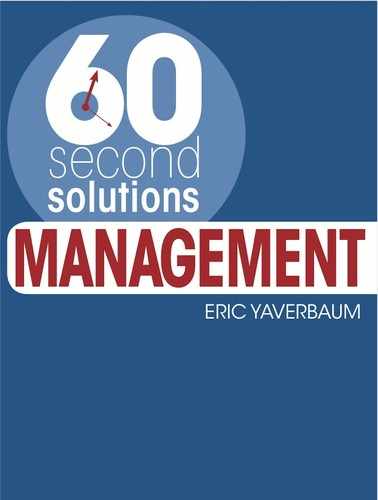SOLUTION 18 GET THE MOST OUT OF MEETINGS
‘Good things, when short, are twice as good.’ Baltasar Gracián
Meetings can be interesting, useful and productive. Making them so is not only possible, it’s your responsibility. All it takes is a little planning and organization to make a meeting go smoothly.
if there is no clear reason for a meeting, don’t schedule one
AVOID COMMON MISTAKES
If you are going to use meetings effectively you must avoid the potential danger areas.
Too little preparation How often have you walked into a meeting only to get a packet of information that you are expected to speed-read and instantly understand?
No focus All too often there is no clear agenda or objective, and people are allowed to drone on, drifting from one irrelevant topic to the next.
Too little follow-up Everyone is frustrated when things are allowed to drift, when there is no meeting summary or follow-through on assigned actions, or evaluation.
The administrative department at a large corporation resolved the problem of having daily staff meetings drag on by holding ‘standing meetings’ in which participants stood up for its duration. Discussions were brief and decisions were prompt.
MAKING MEETINGS GOOD
If you want meetings to work, you need to focus on getting the elements right before, during and after.
Proper preparation Distribute a detailed agenda in advance in sufficient time for attendees to raise questions.
Start on time Begin the discussions whether all attendees have arrived or not – next time they won’t be late.
Keep the discussion on track Stick to the agenda; if important off-track issues are raised, make a note to follow up later.
Keep meetings to time Ten minutes or so before the meeting is scheduled to end, begin to draw the meeting to a close, reviewing and recapping key points, and agreeing follow-up steps. For more on meeting follow-up, see Solution 19.
QUICK FIX: MEETING AGENDA
The agenda helps attendees prepare for a meeting, and it forces you to more thoroughly consider what you want to achieve. Keep the agenda to no more than five topics and outline each in no more than two sentences. If necessary, attach a separate discussion page that provides the detail you want people to know. Identify the discussion time for each agenda item. Make sure the agenda answers the following:
• Where, when and how long is it?
• Who is calling it?
• Who is attending it?
• What is the subject of it?
• What are the topics for discussion?
